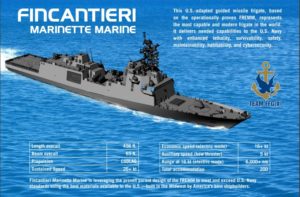The Senate fiscal year 2021 defense spending bill looks to fence off spending on a second Constellation-class (FFG-61) frigate until after Congress gets an updated cost assessment.
The bill provides $1.05 billion for the Navy to procure the second new frigate, but an explanatory statement released with the Senate Appropriations Committee’s draft bill directs no funds for construction of the second ship may be obligated until the Director of Cost Assessment and Program Evaluation (CAPE) “has provided to the congressional defense committees an updated cost assessment for the [Constellation-class frigate] based on the actual contract award and design changes implemented since the previous Independent Cost Estimate.”

The committee released its draft spending bill on Tuesday (Defense Daily, Nov. 10).
In the statement, the committee noted the Navy’s past challenges in managing cost and schedule of lead ships and thus “believes that a high percentage of design completion is necessary to ensure success of this new shipbuilding program.”
The committee cited how in the Littoral Combat Ships arrangements for ship designs were 60 and 34 percent complete for the two variants at the start of construction, subsequently experiencing cost growth over 50 percent.
However, the committee compared that to the status of the Columbia-class ballistic missile submarine with arrangements 100 percent complete and design disclosures over 80 percent complete before construction commenced.
Indeed, in August, Assistant Secretary of the Navy for Research, Development and Acquisition (ASN-RDA) James Geurts told reporters design maturity on the Columbia exceeded 86 percent (Defense Daily, Aug. 14).
Last week, the Navy awarded SSBN builder General Dynamics’ Electric Boat [GD] a $9.47 billion contract modification for full construction of the first Columbia-class vessel and continued advanced constriction for the second vessel (Defense Daily, Nov. 5).
The committee also noted how the Navy has not planned a “gap year” between building the first and second frigates, which could allow for potential design changes to be incorporated into the build plan before constructions starts on the second vessel.
“Instead, the Navy plans to exercise the contract option for the second CCF ship in fiscal year 2021 prior to the conclusion of the Critical Design and Production Readiness Reviews scheduled in fiscal year 2022, and plans to start construction of the second Frigate in the first quarter of fiscal year 2023.”
Given these factors, the committee would restrict funding the second frigate before it is provided the updated cost estimate. The statement also directs the ASN-RDA to provide the defense committees quarterly planned and actual design progress curves for tech requirements, arrangements, design disclosures and work instructions for the frigates leading up to start of construction of FFG-62 no later than with the fiscal year 2022 presidential budget request.
These concerns echo a recent Congressional Budget Office report that found the frigate program could cost up to 40 percent more than the Navy’s estimate, partially based on an independent weight-based cost model. It noted the Navy’s estimated cost per thousand tons is less than both any surface combatant and any non-Navy warship like the Coast Guard National Security Cutter, even as it plans to be more capable than several retired and existing ship classes. (Defense Daily, Oct. 14).
The Navy awarded Fincantieri Marinette Marine a $795 million contract to design and build the first new frigate in April. The contract includes options for the following nine ships that, if exercised, will raise the total contract value to $5.6 billion. The Navy eventually plans to buy 20 total frigates (Defense Daily, April 30).